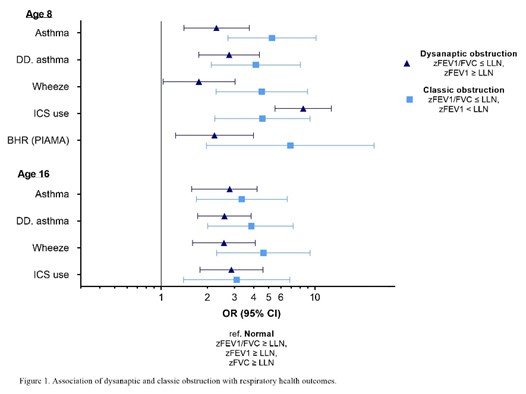Abstract
Background
Airway obstruction is defined as a low FEV1/FVC-ratio. Two types of obstruction exist, one with a low FEV1 (classic) and one with a normal FEV1 and a high FVC(dysanaptic). The clinical significance of dysanaptic obstruction in the pediatric population is unknown.
Aim
To investigate the prevalence of respiratory health outcomes in children/adolescents with dysanaptic, classic obstruction and normal lung function.
Methods
In the BAMSE (Swe) and PIAMA (NL) birth cohorts, obstruction (FEV1/FVC<Lower Limit of Normal) was classified as dysanaptic or classic based on low or normal zFEV1 at ages 8 and 16 (Fig. 1). The association between the two types of obstruction and asthma, wheeze, inhaled corticosteroid (ICS) use and bronchial hyperresponsiveness (BHR, PIAMA only) was estimated by cohort-adjusted logistic regression on pooled data using the normal lung function group as reference.
Results
The prevalence of dysanapsis at age 8 and 16 was 3.9% (106/2744) and 4.6% (121/2649), respectively. At both ages, the dysanaptic and classic obstructive phenotypes had a significantly higher OR for asthma, wheeze and ICS use, compared to normal lung function compared to normal lung function (Fig 1).

Clinical implications
Children/adolescents with dysanaptic obstruction show an equally high prevalence of respiratory outcomes as subjects with classic obstruction. Obstruction, irrespective of the FEV1, should guide follow-up and treatment.